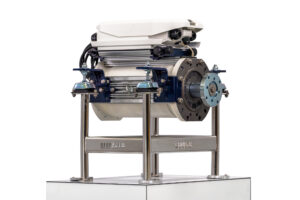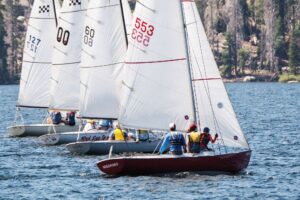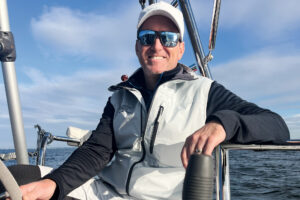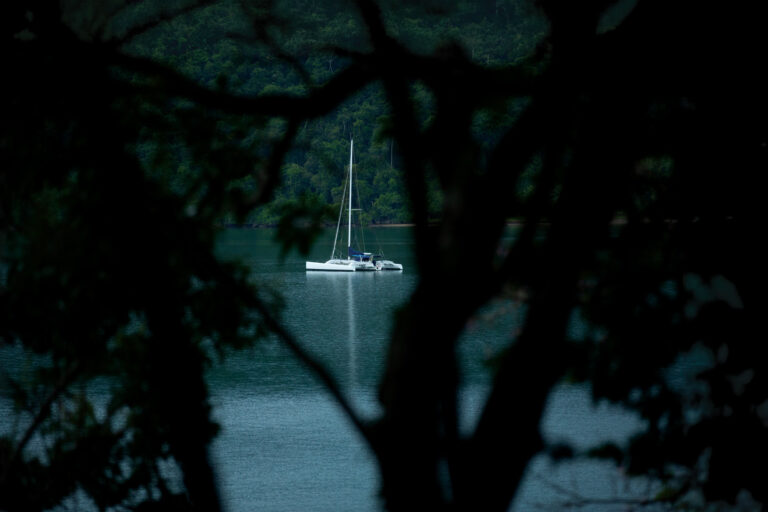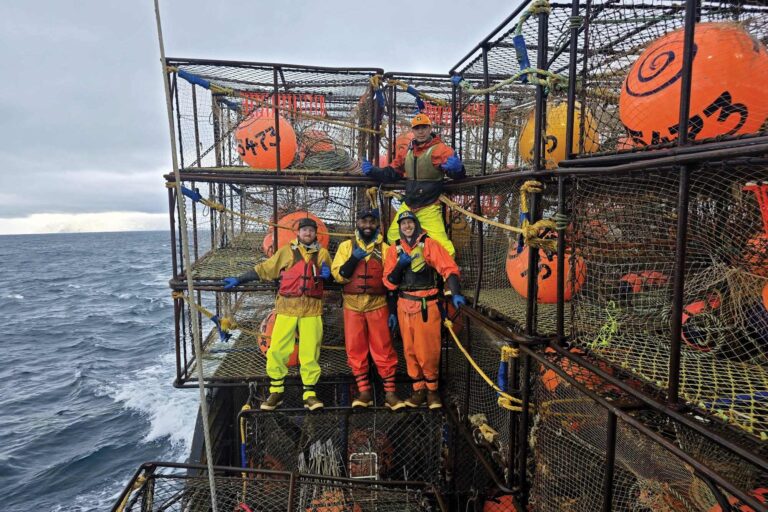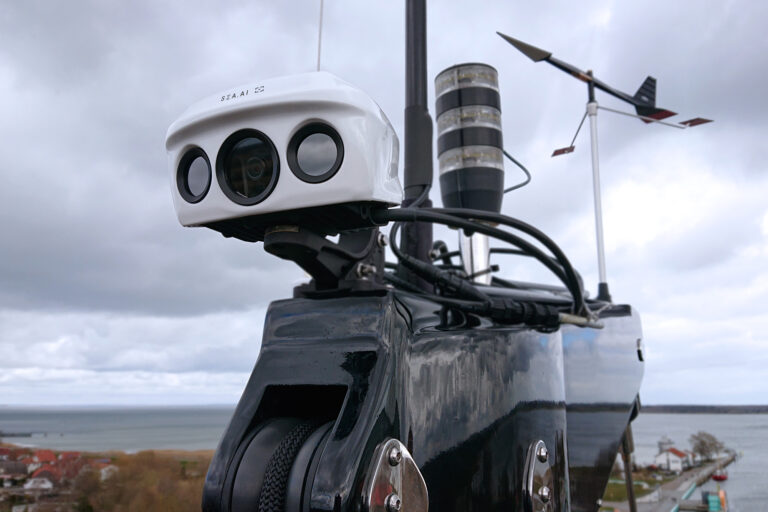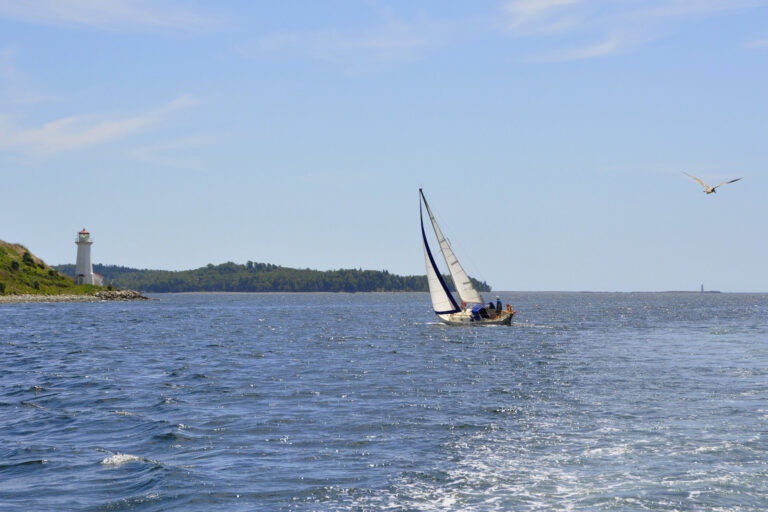
New Morning 368
On this early November afternoon, despite the sunlight burning through hazy clouds, the 10-knot southwest breeze that blew across the water was losing its summer warmth and made a windbreaker welcome as we beat south out of Narragansett Bay, past Castle Hill, across to the shore along Rhode Island’s southern coast, then tacked off shore again. Much of America was at work on this Tuesday, or perhaps they’d taken a break to visit a polling place to elect a new president. We, on the other hand-Fay Mark, Russ Irwin, and me-had all, for various reasons, cast absentee ballots. They’d done so because they were bound for the Caribbean and wanted to vote for the eventual winner, who’d they supported early and richly; me, well, I work some distance from home and wanted my vote to count, too. And so it was that we were free to guiltlessly enjoy this spectacular afternoon and ride on New Morning, their Chuck Paine-designed sloop. The drop-dead gorgeous 54-footer was built in Maine by Lyman-Morse Boatbuilding.
From her proud stem to sugar-scoop stern, I quickly concluded that New Morning is very much a sum that’s greater than any of her parts. She draws her charm equally from the powerful lines of her designer, the meticulous craftsmanship of her builder, and the very distinct wish list that her owners brought to the table via a Russ-authored design brief that stretched on for some 15 pages.
Because Russ and Fay are laid-back in that West Coast sort of way that turns a new acquaintance into a willing accomplice-they’re recovering Silicon Valley techies-my dockside visit to see New Morning a day earlier quickly evolved into an afternoon-long exploration of the boat and how it came into being as well as an offer for an Election Day sail to see how all the details worked together out on the water. And those details were in abundance. Russ and Fay had taken what they’d learned from buying and sailing a Swan 44 Mark II on San Francisco Bay, added details they’d admired from Van de Stadt-designed Trintellas and other boats they’d visited while on charters and at boat shows, then wrapped them around what they intended to be the perfect means to reach the Caribbean and their home once there.
Here’s what they wanted: A 50- to 60-foot circumnavigator that would sail primarily in the tropics but could be comfortable anywhere 50 degrees north or south of the equator. The boat was also designed primarily for a couple who’ll live aboard all but six to eight weeks a year; 85 percent of the time would be spent at anchor, the rest under way. The taller owner (Russ, who stands six-foot-one) needs headroom; the shorter is a gourmet cook. Both enjoy their time together, but each appreciates his or her own space. Need to know more? Visit their website (www.newmorning.info) and download the entire design brief. Want to know how it turned out? Read on.
Approaching the boat dockside during its Newport, Rhode Island, stopover while en route from Maine to Bermuda, I recognized at once that New Morning had the signature lines of a Chuck Paine cruiser: the elegant and gentle sheer, the low cabin top, a hard dodger, robust rubrails. Climbing aboard, I couldn’t help but notice the solid feel of the boat, the clean deck layout, and the beefy Harken electric winches and hardware intended for shorthanded offshore sailing.
I also noticed the complete lack of brightwork. Instead, the deck layout has an almost workboat simplicity, enhanced by what Russ calls a “shark cage” aft pulpit-it surrounds the cockpit with three stainless-steel rails that wrap around the stern and flow forward to the lifeline gates and 30-inch-tall stanchions located nearly amidships.
“I don’t want to spend my time sanding and varnishing,” said Russ, who once owned an all-mahogany sailboat with a bright-finished exterior.
Stepping aboard through the open transom and between the twin wheels, I could easily put a hand on either, and I noticed as I moved forward that the cockpit sole seemed narrow for a boat with 15-plus feet of beam. Again, there’s no accident in these details. Looking forward to many solo watches and offshore miles, Russ and Fay wanted a secure cockpit with working area just big enough for the two of them. They’d gladly step out of each other’s way when moving about at the dock as a trade-off for safety and practicality while offshore.
They told the story of the first sea trial, when New Morning headed down the river from Thomaston, Maine, with a dozen or more people on board. It was in May 2008, 31 months after the project was started and 21 months after building commenced. The wind was blowing 25 to 30. They had two reefs in the main and the nonoverlapping jib unfurled, and everyone seemed to be in each other’s way on this boat built for a couple. Alone, though, Russ and Fay can tack the boat in a snap-think synchronized sailing: Russ, standing at one of the two wheels, hits the auto-tack button on the Furuno autopilot and releases the jib. Fay winches her sheet home from the other side. When it’s time to tack again, they simply repeat the process, she releasing, he winding in. As they sit under the dodger, out of the wind and eating sandwiches, I try a couple of tacks on my own to get a feel for it. It’s a breeze; I put the wheel over, release a sheet, walk a couple of steps, straighten the helm, and sheet in.
Russ tells me I’m working too hard and says that’s not how it should be done. I should use the autopilot to steer. That’s what it’s there for.
Admonished, I sit and listen while he and Fay explain the theory of the space they’ve created under the dodger. They tell me how the extent of its roof and the length of the benches on either side are both designed so that when Russ is relaxing with his back against the cabin in the hot tropical sun, shade covers his body to the tips of his toes. But when Fay and Russ sit at the other ends of the benches in the evening, they have a full view of the nighttime stars that’s unfettered in any way by the dodger.
Overhead, the solid fiberglass dodger and carbon-fiber arch provides a beefy anchor point for the midboom-sheeted main and doubles as a platform for six solar panels; with four more mounted on deck just ahead of the dodger, New Morning’s electrical system can harvest a theoretical 568 watts when the sun’s out. The solar panels, coupled with a Superwind 350 wind generator on a tower on the stern, allowed Fay and Russ to anchor off Grand Case, St. Martin, without running the engine for 10 days. Add in a pair of engine-driven high-output alternators and there’s power-generating capacity aplenty for the 12 gel-cell batteries that make up the 1,000 amp-hour house battery bank. It fuels a 24-volt electrical system, which includes an inverter and 12-volt power for navigation electronics.
Why do they need all that power? Well, Fay and Russ are decidedly not camping. Though they’ve tried to hold down consumption by using LED lighting wherever possible and seeking out other low-draw appliances, they still like their toys-Apple computers with big display screens, in particular. And then there’s the air-conditioning in the forward cabin, the Spectra Newport Mark II watermaker, and an Espar heater for when the nights turn cold. Russ acknowledges that he and Fay likely make-and consume-more juice than other cruisers.
And why not? New Morning’s interior is as plush and comfortable as her exterior is tough and no-nonsense, so why not enjoy it? Woodwork throughout is a matte-finished light maple and comprised of a mixture of solid wood and veneer-covered foam-cored panels. The sole is teak.
Fay’s love of turning local provisions into sumptuous hors d’oeuvres and meals is aided and abetted by an in-line galley to port of the companionway. When I looked, both fridges and the freezer, all in a line inboard, were jam-packed for the trip south. Outboard there’s lots of counter space, deep double sinks, a stove and oven, and, at the very aft end, a stainless-steel portion of the countertop that can fold out to double as Russ’ workbench.
At home in Sausalito, Fay enjoys a kitchen that’s near to where Russ has his computer, so they can talk while working separately. Ditto on the boat, where the hexagonal shape of the main saloon keeps the chef close to Russ, a.k.a. Mr. Gadget. Forward, the computer station/nav desk blends into a curved settee with a sharp-angled hexagonal dining table. To starboard, there’s a pair of comfortable chairs with a small table between. Metal artwork by Fay’s sister, Evy Rogers, of Jacob Rogers Art, is incorporated into the end tables, one of which doubles as a wine rack.
To starboard of the companionway, there’s a guest head; farther aft, a guest cabin has a fold-down berth that awaits the off-watch partner or friends who might come calling in port.
The owners’ stateroom-used here in the fullest sense of the word-is forward. A centerline island queen dominates the cabin, though there’s plenty of room to move about and dress. And there’s lots of storage, as you’d expect on a boat designed to be in use 40-plus weeks a year. My two favorite features in the owners’ stateroom: the easy-to-install headpiece that turns the bed into a massage table (so Californian) and the etched-glass panel that lets light into the full-size stall shower. Much of the success of the interior, said Paine, is due to the ideas of Jane Plachter-Vogel, the Fort Lauderdale, Florida, designer who contributed as a consultant on the project.
New Morning’s hull and deck were built by Lyman-Morse of E-glass and vinylester resin over Corecell foam. Her swept-back carbon-fiber rig with triple spreaders is by Offshore Spars. I found that New Morning, even in light air, accelerated quickly with the full-batten main and 107-percent jib, and it’s a sail plan that can be easily tamed if things become dicey. An A-sail is also available to keep things interesting.
On the day we were out, Russ couldn’t help but demonstrate the multipurpose lines running the length of each wide side deck. Set one way, they serve as preventers for the boom, but they can also be used, depending on your wishes, as foreguys or to adjust the genoa cars.
So in the end, I had just one overriding question-aside, that is, from “Hey, how much fun would it be to sail this boat to somewhere warm?”
It was this: “What do you call this marvelous and in all likelihood one-off sailboat that’s a delightful blend of design excellence, world-class glasswork and joinery, and the whims of two very laid-back but demanding owners?” A Chuck Paine Bermuda 54? A Lyman-Morse 54?
“Building a custom boat is like building a custom house,” says Fay, describing what it’s like to be surrounded by the fruits of your own ideas. “It’s sooo Fay.”
No, make that sooo Russ and Fay.
Mark Pillsbury is editor of Cruising World.
Specs
LOA 53′ 9″ (16.38 m.)
LWL 46′ 11″ (14.30 m.)
Beam 15′ 4″ (4.67 m.)
Draft 7′ 6″ (2.29 m.)
Sail Area (100%) 1,337 sq. ft. (124.2 sq. m.)
Ballast 16,610 lb. (7,534 kg.)
Displacement 44,600 lb. (20,231 kg.)
Ballast/D .37
D/L 193
SA/D 17.0
Water 145 gal. (549 l.)
Fuel 287 gal. (1,086 l.)
Mast Height 80′ 00″ (24.38 m.)
Designer Chuck Paine
Lyman-Morse Boatbuilding
(207) 354-6904
www.lymanmorse.com

